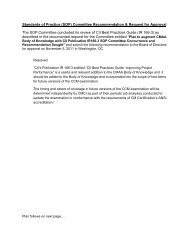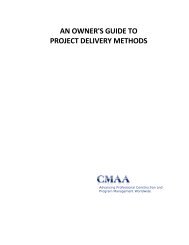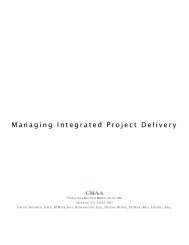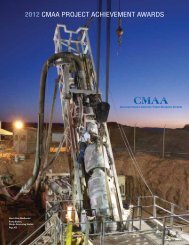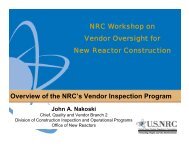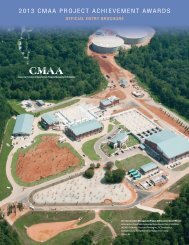A Case Study of Construction Management - CMAA
A Case Study of Construction Management - CMAA
A Case Study of Construction Management - CMAA
Create successful ePaper yourself
Turn your PDF publications into a flip-book with our unique Google optimized e-Paper software.
January 2001<br />
A CASE STUDY OF CONSTRUCTION MANAGEMENT<br />
ON THE BOSTON HARBOR PROJECT<br />
REFLECTIONS AT PROJECT COMPLETION<br />
BY WALTER G. ARMSTRONG AND<br />
RALPH M. WALLACE<br />
PROJECT BACKGROUND<br />
The Boston Harbor Project is the largest court-ordered compliance action in the history <strong>of</strong><br />
the Clean Water Act. The project emerged from a unique set <strong>of</strong> economic and political<br />
circumstances and the approach adopted to manage the Boston Harbor Project was<br />
greatly influenced by the historical context in which the project was created.<br />
Decades <strong>of</strong> Neglect<br />
Boston Harbor has achieved notoriety as a dumping ground, from the famous Tea Party in<br />
1773 through the heated debates <strong>of</strong> the1988 presidential election campaign. Wastewater<br />
generated by the Boston region was discharged into the harbor from two undersized and<br />
outmoded primary treatment plants. Lacking processing facilities for upland disposal,<br />
these plants also discharged 70 tons <strong>of</strong> sludge into the harbor each day during outgoing<br />
tides. The combined discharge <strong>of</strong> marginally treated primary effluent and sludge into the<br />
shallow waters <strong>of</strong> Boston Harbor imposed a significant burden on the marine ecology and<br />
resulted in serious deterioration <strong>of</strong> the aesthetic, commercial and recreational qualities <strong>of</strong><br />
this vital resource.<br />
Passage <strong>of</strong> the Federal Clean Water Act in 1972 required that all municipal sewage<br />
treatment systems incorporate secondary treatment by 1977. Secondary treatment<br />
provides removal <strong>of</strong> significantly higher levels <strong>of</strong> both solids and biochemical oxygen<br />
demand from wastewater. These new standards placed the Metropolitan District<br />
Commission, the agency responsible for wastewater treatment for much <strong>of</strong> the Boston<br />
metropolitan region, in violation <strong>of</strong> the law. The law, however, allowed jurisdictions that<br />
discharged into coastal waters to apply for waivers from the secondary treatment<br />
requirement. The Metropolitan District Commission applied to the U.S. Environmental<br />
Protection Agency (EPA) for such a waiver in late 1979.<br />
The EPA was slow to act on the waiver request and the continuing deterioration <strong>of</strong> Boston<br />
Harbor prompted affected communities and environmental groups to take action. In<br />
1982, the City <strong>of</strong> Quincy, location <strong>of</strong> the then 30-year-old Nut Island Treatment Plant, filed a<br />
suit in Massachusetts Superior Court charging violations <strong>of</strong> laws prohibiting discharges into<br />
coastal and tidal waters. The court imposed a moratorium on new sewer hookups in the<br />
Copyright ©2001 by the <strong>Construction</strong> <strong>Management</strong> Association <strong>of</strong> America
January 2001<br />
A <strong>Case</strong> <strong>Study</strong> <strong>of</strong> <strong>Construction</strong> <strong>Management</strong><br />
On the Boston Harbor Project<br />
Reflections at Project Completion<br />
Boston region, raising the issue to new heights <strong>of</strong> public awareness. Although the<br />
moratorium was quickly overturned on procedural grounds, the threat <strong>of</strong> halting new<br />
construction during an economic boom in the region provided increased impetus for<br />
resolving the problem.<br />
The legislative response was to create an independent state authority. In late 1984, the<br />
Massachusetts Water Resources Authority (MWRA) assumed responsibility from the<br />
Metropolitan District Commission (MDC) for providing wholesale water and sewer services<br />
to 60 eastern Massachusetts communities. In addition to its operating responsibilities, the<br />
new authority was made responsible for rehabilitating the water and sewer systems and<br />
bringing them into compliance with applicable environmental laws. In effect, the fledgling<br />
authority was charged with the long-awaited cleanup <strong>of</strong> Boston Harbor.<br />
Within a month <strong>of</strong> its creation, the authority became a defendant in a suit brought by the<br />
Conservation Law Foundation and the U.S. Environmental Protection Agency over the<br />
MDC’s failure to comply with the Clean Water Act. On September 5, 1985, U.S. District<br />
Court Judge A. David Mazzone ruled that discharges into Boston Harbor were in violation<br />
<strong>of</strong> the Clean Water Act. Following intense negotiations, a court-ordered schedule for<br />
constructing modern secondary treatment facilities to serve the Boston region was issued<br />
on May 8, 1986. The court order required the authority to commence construction <strong>of</strong> new<br />
primary treatment facilities in 1990 and complete all facilities by 1999.<br />
Economic Climate<br />
The long debate and associated delay surrounding the cleanup <strong>of</strong> Boston Harbor resulted<br />
in losing the opportunity to seek federal funding for the bulk <strong>of</strong> the harbor cleanup’s<br />
projected cost. During the 1970’s the federal government provided up to 75 percent <strong>of</strong><br />
the funds necessary to construct wastewater treatment facilities. Throughout the 1980’s,<br />
however, the total amount <strong>of</strong> federal grants declined steadily. By the end <strong>of</strong> the decade,<br />
federal grants for constructing sewage treatment facilities ceased. The federal role was<br />
ultimately re-defined to help states capitalize low interest loan programs from which local<br />
communities could borrow. Boston, like San Diego, Los Angeles and other coastal cities<br />
which had sought secondary treatment waivers, was now facing an extraordinary financial<br />
burden to achieve compliance with the Clean Water Act.<br />
Financing the Boston Harbor Project was further complicated by a sharp downturn in the<br />
local economy. During the 1980’s, Boston had one <strong>of</strong> the strongest economies in the U.S.,<br />
driven by the concentration <strong>of</strong> high technology industries within the region. Unfortunately,<br />
the “Massachusetts miracle” ended just as the Boston Harbor Project began.<br />
Unemployment rates in late 1989 rose in the Commonwealth while they declined for the<br />
nation as a whole. The economic downturn was disastrous for state revenue receipts.<br />
Massachusetts ended fiscal year 1990 with a $1 billion deficit.<br />
Copyright ©2001 by the <strong>Construction</strong> <strong>Management</strong> Association <strong>of</strong> America 2
January 2001<br />
A <strong>Case</strong> <strong>Study</strong> <strong>of</strong> <strong>Construction</strong> <strong>Management</strong><br />
On the Boston Harbor Project<br />
Reflections at Project Completion<br />
Lacking federal funding, the cost <strong>of</strong> the Boston Harbor Project would be largely borne by<br />
the MWRA’s ratepayers, the households and businesses who are the ultimate consumers <strong>of</strong><br />
the services it provides, and as the project shifted into construction the charges for sewer<br />
service in the Boston region grew dramatically. In 1984, prior to the creation <strong>of</strong> the MWRA,<br />
the typical household paid less than $100 per year for sewer services. From 1985 to 1990,<br />
the MWRA increased total sewage charges by nearly 400 percent and planners forecast<br />
that average household charges would exceed $1,200 by 2000 when the project was to<br />
be completed. In response, the public outcry against the costs <strong>of</strong> the Boston Harbor<br />
Project mounted, culminating in the Spring <strong>of</strong> 1993, when 300 ratepayers re-enacted a<br />
modern version <strong>of</strong> the Boston Tea Party by donning colonial clothes and tossing their water<br />
and sewer bills into the harbor.<br />
Shortly thereafter, the state legislature created a debt service assistance program to help<br />
mitigate the annual increases in sewer bills and the Massachusetts legislative delegation<br />
was successful in securing Federal aid, which ultimately funded approximately 20% <strong>of</strong> the<br />
cost <strong>of</strong> the Boston Harbor Project. These resulted in significantly lower annual rate<br />
increases, however, the intense public scrutiny and unrelenting pressure to control and<br />
hopefully reduce the projected cost <strong>of</strong> the Boston Harbor Project remained and became<br />
deeply ingrained in the project’s management approach.<br />
Project Description<br />
The Boston Harbor Project (BHP) is one <strong>of</strong> the largest wastewater projects ever undertaken<br />
in the United States. The project involves the planning, design, construction and start-up <strong>of</strong><br />
a vast new wastewater treatment system costing $3.6 billion. Except for final paving and<br />
landscaping, the project is complete as <strong>of</strong> December 2000 and provides secondary<br />
treatment <strong>of</strong> wastewater generated by more than 2 million residents and over 5,500<br />
businesses in the greater Boston metropolitan area.<br />
The project consists <strong>of</strong> five major components:<br />
� Primary treatment facilities, consisting <strong>of</strong> four batteries <strong>of</strong> primary clarifiers, an onisland<br />
headworks, pump stations and disinfection facilities. In dry weather, the<br />
primary plant handles roughly 350 million gallons per day, but can handle peak<br />
wet weather flows <strong>of</strong> 1.27 billion gallons per day.<br />
� Secondary treatment facilities, consisting <strong>of</strong> three batteries <strong>of</strong> secondary reactors<br />
and clarifiers, supported by a cryogenic oxygen plant, capable <strong>of</strong> treating up to<br />
780 million gallons per day.<br />
� A remote headworks facility providing pretreatment to 400 million gallons per<br />
day <strong>of</strong> wastewater from the southern part <strong>of</strong> the Boston region connected to a<br />
4.8 mile long rock Inter-Island Tunnel that transports these flows beneath Boston<br />
Harbor to the Deer Island Treatment Plant.<br />
Copyright ©2001 by the <strong>Construction</strong> <strong>Management</strong> Association <strong>of</strong> America 3
January 2001<br />
A <strong>Case</strong> <strong>Study</strong> <strong>of</strong> <strong>Construction</strong> <strong>Management</strong><br />
On the Boston Harbor Project<br />
Reflections at Project Completion<br />
� A 9.5 mile long rock Effluent Outfall Tunnel which discharges treated effluent into<br />
the deep waters <strong>of</strong> Massachusetts Bay through a series <strong>of</strong> 55 diffusers spaced<br />
along the last 1.5 miles <strong>of</strong> the tunnel.<br />
� On-island residuals processing facilities (including the project’s landmark eggshaped<br />
digesters) and an <strong>of</strong>f-island sludge pelletizing plant that convert sludge<br />
generated by the new plant into 33,000 dry tons <strong>of</strong> fertilizer annually.<br />
In addition, the development <strong>of</strong> an extensive network <strong>of</strong> utilities and support activities was<br />
required to support construction and ongoing operation <strong>of</strong> the new treatment plant,<br />
including:<br />
� On-island and <strong>of</strong>f-island utilities to support both construction and ongoing<br />
operations, featuring a thermal/power plant capable <strong>of</strong> generating over 70megawatts<br />
<strong>of</strong> electricity.<br />
� Extensive demolition/site preparation and the implementation <strong>of</strong> a public access<br />
plan (the perimeter <strong>of</strong> Deer Island and Nut Island, the two principal construction<br />
sites, are part <strong>of</strong> the recently created Boston Harbor Islands National Seashore).<br />
� On-island and <strong>of</strong>f-site transportation facilities and the associated bus and water<br />
transportation services to move workers, equipment and material to/from Deer<br />
Island.<br />
The design and construction for the project involved the execution <strong>of</strong> 32 design contracts<br />
and 133 construction and support services contracts. Ultimately, the activities <strong>of</strong> multiple<br />
contractors, subcontractors, and material and equipment vendors needed to be<br />
scheduled, coordinated and tracked to ensure that delays were avoided, the aggressive<br />
court schedule was met, and costs were rigorously controlled.<br />
In any situation, managing a large, multi-year capital program poses a formidable<br />
management challenge. The complexity <strong>of</strong> the management task faced by the MWRA<br />
was further compounded by several factors associated with the Boston Harbor Project,<br />
particularly with the determination that Deer Island (a small peninsula at the entrance <strong>of</strong><br />
Boston Harbor) was the only feasible location for the treatment facility. The major factors<br />
adding to the project’s complexity were:<br />
� Schedule constraints - The aggressive Court-ordered schedule required plant<br />
construction to commence by December 1990. The new primary plant was to<br />
be completed by 1995 and all process facilities were to be completed by<br />
December 1999.<br />
� Site constraints – The small Deer Island site strongly influenced the design <strong>of</strong> the<br />
new treatment facilities (requiring use <strong>of</strong> space saving designs more commonly<br />
found outside the U.S.), affected the phasing <strong>of</strong> construction, and required use<br />
<strong>of</strong> <strong>of</strong>f-site locations for construction staging. In addition, roadway access was<br />
limited to narrow two-lane streets winding through dense residential<br />
neighborhoods that could not support the massive volume <strong>of</strong> construction traffic.<br />
Copyright ©2001 by the <strong>Construction</strong> <strong>Management</strong> Association <strong>of</strong> America 4
January 2001<br />
A <strong>Case</strong> <strong>Study</strong> <strong>of</strong> <strong>Construction</strong> <strong>Management</strong><br />
On the Boston Harbor Project<br />
Reflections at Project Completion<br />
� Mitigation commitments - All construction was to occur close to established<br />
residential neighborhoods and access to the construction sites was through<br />
these communities. To mitigate construction impacts, the MWRA moved<br />
essentially all equipment, and materials to/from Deer Island by barge and almost<br />
all workers were transported to the site by bus or passenger ferry service.<br />
Stringent limitations on air emissions, noise and visual impacts were also<br />
established for both construction and operation <strong>of</strong> the new plant.<br />
� Maintain existing operations - The design <strong>of</strong> the new facilities and phasing <strong>of</strong><br />
construction had to permit the ongoing operation <strong>of</strong> two existing wastewater<br />
treatment facilities.<br />
� Competition with other projects - The Boston Harbor Project had to be<br />
coordinated with other major construction projects in the Boston area,<br />
particularly the $14 billion Central Artery/Third Harbor Tunnel project, which<br />
would exert concurrent demands for available resources, including<br />
management, labor, equipment, materials, water transportation, and disposal<br />
sites for excess materials.<br />
� The successful management <strong>of</strong> the project depended on the ability to<br />
overcome the obstacles described above, control project costs, complete the<br />
construction within the court mandated timetable, deliver quality operable<br />
facilities, and maintain a positive relationship with affected communities.<br />
SELECTING AND IMPLEMENTING<br />
A PROJECT MANAGEMENT STRUCTURE<br />
The aggressive court-ordered schedule, intense public pressure for cost control and<br />
daunting logistical challenges associated with the Boston Harbor Project dictated that the<br />
MWRA quickly implement an effective management structure to take the project from the<br />
facilities planning stage into design, construction and start-up. As a new agency, the<br />
MWRA had relied heavily on consultants to prepare the secondary treatment facilities<br />
plan. Within the authority, responsibility for managing the project initially resided with the<br />
MWRA’s engineering division, which was responsible for all MWRA engineering and<br />
construction projects encompassing both rehabilitation projects and the new capital<br />
projects generated by the court order. The MWRA was able to assign only two full time<br />
staff to manage the facilities plan for what was projected to be a $4.0 billion program.<br />
Although this structure was successful for the initial facilities planning phase <strong>of</strong> the program,<br />
the MWRA faced numerous questions as the project was ready to progress into the more<br />
intensive phases <strong>of</strong> design and construction:<br />
� How could MWRA maintain adequate control over the design and construction<br />
<strong>of</strong> the new court-ordered facilities? What was the preferred organizational<br />
structure for generating effective agency oversight?<br />
Copyright ©2001 by the <strong>Construction</strong> <strong>Management</strong> Association <strong>of</strong> America 5
January 2001<br />
A <strong>Case</strong> <strong>Study</strong> <strong>of</strong> <strong>Construction</strong> <strong>Management</strong><br />
On the Boston Harbor Project<br />
Reflections at Project Completion<br />
� How could the MWRA effectively manage the $4.0 billion Boston Harbor Project<br />
while concurrently implementing a $100 million per year system-wide capital<br />
rehabilitation program?<br />
� What would be the role <strong>of</strong> private firms and how should the private sector<br />
resources be organized? How should the relationship between in-house (public)<br />
and private sector resources be structured?<br />
In developing answers to these questions, the authority reviewed the management<br />
approaches used by two relevant large-scale public works projects: the North River Water<br />
Pollution Control Plant in New York City and the Central Artery/Third Harbor Tunnel in<br />
Boston.<br />
New York City’s North River Water Pollution Control Plant was selected because it was one<br />
<strong>of</strong> the most expensive wastewater treatment plant under construction at the time and<br />
presented complex construction management issues. The facility, which cost $1.1 billion,<br />
was constructed on a small site with its limited access impeded by a major highway<br />
rehabilitation project. Like the planned MWRA facilities, the project had to conform to<br />
milestone dates stipulated in a federal court order. The management approach for the<br />
North River Plant was distinguished by the following characteristics:<br />
� Use <strong>of</strong> consultants for design and construction management <strong>of</strong> the plant - This<br />
decision reflected recognition <strong>of</strong> the project’s complexities and the internal<br />
resource constraints <strong>of</strong> an agency (the New York City Department <strong>of</strong><br />
Environmental Protection or NYC/DEP) already encumbered by substantial<br />
ongoing capital and operating responsibilities. The reliance on consultants was<br />
particularly significant in this case because the agency had previously designed<br />
a 300 million gallon per day wastewater treatment plant entirely with in-house<br />
staff.<br />
� Retention <strong>of</strong> agency control in key programmatic areas – Although the<br />
consultant team had primary responsibility for design engineering and<br />
construction management, the NYC/DEP elected to maintain management<br />
control, allow its own staff to have input into the design process, and retained<br />
the authority to advertise bids, select contractors, issue change orders and make<br />
progress payments. The consultant had input on these decisions, but only<br />
NYC/DEP could provide final written approval.<br />
� Integration <strong>of</strong> construction–related knowledge into the design and<br />
implementation process – NYC/DEP recognized that the project’s planning and<br />
design would have a direct impact on the ability to manage construction<br />
effectively. Therefore, construction-oriented personnel were involved in design<br />
reviews, value engineering, scheduling and cost estimating early in the project.<br />
The Central Artery/Third Harbor Tunnel Project was selected because <strong>of</strong> its similar scale,<br />
geographic proximity, similar requirements in labor and materials, and similar logistical<br />
issues, such as material disposal. With the goal <strong>of</strong> doubling the capacity <strong>of</strong> the Central<br />
Copyright ©2001 by the <strong>Construction</strong> <strong>Management</strong> Association <strong>of</strong> America 6
January 2001<br />
A <strong>Case</strong> <strong>Study</strong> <strong>of</strong> <strong>Construction</strong> <strong>Management</strong><br />
On the Boston Harbor Project<br />
Reflections at Project Completion<br />
Artery and moving traffic from west and south <strong>of</strong> Boston to Logan Airport without passing<br />
through downtown Boston and East Boston, the project was estimated at that time to cost<br />
approximately $4.4 billion.<br />
The approach adopted by the original sponsoring agency (Massachusetts Department <strong>of</strong><br />
Public Works or MDPW) shared many similarities and has some differences in approach to<br />
the North River Plant. The similarities are:<br />
� The use <strong>of</strong> outside consultants rather than in-house staff for design and<br />
construction services;<br />
� The retention <strong>of</strong> agency control <strong>of</strong> areas such as contractor selection, change<br />
orders and progress payments; and<br />
� The integration <strong>of</strong> construction-related knowledge into the design and<br />
implementation process.<br />
The main ways in which the two approaches differed are:<br />
� The creation <strong>of</strong> a special program management <strong>of</strong>fice within the sponsoring<br />
agency – The MDPW created an in-house program management group to<br />
provide oversight and monitoring <strong>of</strong> the consultant team. The group, which<br />
initially consisted <strong>of</strong> 40 people, had management, technical and support<br />
personnel. The responsibilities and organization <strong>of</strong> the in-house team mirrored<br />
those <strong>of</strong> the consultant team for effective interaction.<br />
� Early decision to use a single firm to manage both design and construction<br />
services – Both MDPW and the NYC/DEP used a single team to manage the<br />
design and construction <strong>of</strong> their respective projects. MDPW made this judgment<br />
at the start <strong>of</strong> design and sought an integrated team with multiple capabilities.<br />
NYC/DEP, perhaps because <strong>of</strong> the more specialized design requirements<br />
associated with secondary treatment facilities, initially sought the best design<br />
engineering team and later decided to use the same team for construction<br />
management services.<br />
� Use <strong>of</strong> multiple design firms – In the Central Artery/Third Harbor Tunnel Project, the<br />
prime consultant team has overall responsibility for design but does not perform<br />
all design functions. The approach is for the prime consultant to prepare the<br />
conceptual design and the MDPW contracts directly with “section designers”<br />
who complete the detailed design <strong>of</strong> various project components.<br />
Implementation <strong>of</strong> a <strong>Management</strong> Approach for the Boston Harbor Project<br />
In September 1987, the MWRA Board <strong>of</strong> Directors approved a recommendation to recruit a<br />
management team consisting <strong>of</strong> three components to manage the Boston Harbor Project:<br />
Copyright ©2001 by the <strong>Construction</strong> <strong>Management</strong> Association <strong>of</strong> America 7
January 2001<br />
A <strong>Case</strong> <strong>Study</strong> <strong>of</strong> <strong>Construction</strong> <strong>Management</strong><br />
On the Boston Harbor Project<br />
Reflections at Project Completion<br />
� a newly created in-house team dedicated solely to the project, known as the<br />
Program <strong>Management</strong> Division;<br />
� a consultant team to serve as Program/<strong>Construction</strong> Manager; and<br />
� a second consultant team to serve as Lead Design Engineer.<br />
This management model adapted many ideas from both the North River Treatment Plant<br />
and the Central Artery/Third Harbor Tunnel, but differed with them in several respects, most<br />
notably, in the decision to clearly separate responsibility for design and construction<br />
management.<br />
The Program <strong>Management</strong> Division<br />
The mission <strong>of</strong> the MWRA’s Program <strong>Management</strong> Division (PMD) is to provide the authority<br />
with control and oversight <strong>of</strong> the Boston Harbor Project. PMD has been responsible for the<br />
executive direction, management and coordination <strong>of</strong> the program, including oversight <strong>of</strong><br />
consultants. Through PMD, the MWRA retained the sole authority to bid and award<br />
contracts, select consultants, authorize change orders and progress payments, and resolve<br />
claims. The MWRA also retained the ability to perform independent review <strong>of</strong> all consultant<br />
work products.<br />
As with the Central Artery/Third Harbor Tunnel Project, the MWRA saw the following<br />
advantages in creating a dedicated in-house team:<br />
� prevent the project from consuming the resources <strong>of</strong> existing engineering and<br />
construction staff, which had on-going responsibility for a sizeable ($100 million<br />
per year) capital program;<br />
� focus the full attention <strong>of</strong> a specific group <strong>of</strong> individuals on the harbor project<br />
rather than involving staff with multiple responsibilities; and<br />
� provide the opportunity for the MWRA to recruit personnel with the needed<br />
program management skills from within and outside MWRA.<br />
The team was initially composed <strong>of</strong> individuals with backgrounds in design engineering,<br />
construction management, finance and budgeting, contract administration, program<br />
management, information systems, environmental planning and community relations.<br />
Approximately 85 percent <strong>of</strong> the staff was recruited from outside the MWRA and 60<br />
percent <strong>of</strong> the initial PMD staff had some private sector work experience. PMD’s staffing<br />
peaked at 51 during the design and early construction phase and has subsequently<br />
decreased to 22 as the project reached substantial completion. Over time, the mix <strong>of</strong> skills<br />
Copyright ©2001 by the <strong>Construction</strong> <strong>Management</strong> Association <strong>of</strong> America 8
January 2001<br />
A <strong>Case</strong> <strong>Study</strong> <strong>of</strong> <strong>Construction</strong> <strong>Management</strong><br />
On the Boston Harbor Project<br />
Reflections at Project Completion<br />
has also changed in response to shifting project needs, with a greater emphasis on<br />
construction management, contract administration and claims/litigation management.<br />
Two-thirds <strong>of</strong> the current staff were drawn from outside the MWRA and 60 percent <strong>of</strong> the<br />
remaining staff has private sector work experience, primarily with consultant engineering<br />
firms.<br />
Program/<strong>Construction</strong> Manager<br />
A Program/<strong>Construction</strong> Manager (P/CM) was incorporated into the management<br />
structure to bring an organized, systematic approach to managing the program from preconstruction<br />
planning and design through start-up and acceptance <strong>of</strong> the new facilities.<br />
Day-to-day program management responsibilities reside with the P/CM rather than the<br />
MWRA’s in-house staff.<br />
As previously discussed, the aggressive court mandated timetable, the requirement for<br />
careful coordination <strong>of</strong> numerous contractors, subconsultants and equipment vendors on<br />
constrained construction sites, and the project’s logistical challenges necessitated the use<br />
<strong>of</strong> an experienced, private-sector construction management firm. The use <strong>of</strong> such a firm<br />
was also viewed as providing a program-wide perspective that would increase the<br />
likelihood <strong>of</strong> meeting the project’s schedule and cost objectives, and integrate<br />
construction-related knowledge into the design and implementation process.<br />
As the principal management consultant, the P/CM has responsibility for resident<br />
engineering and inspection, project scheduling, cost estimating, contract administration,<br />
document control and information systems, community relations, environmental permitting,<br />
water transportation, bulk materials handling, value engineering, pre-purchase <strong>of</strong><br />
equipment, facility testing, start-up and staff training. The P/CM team for the Boston Harbor<br />
Project is led by Earth Tech, Inc. (formerly Kaiser Engineers), with Stone & Webster serving as<br />
its principal subconsultant. This team began work in April 1988.<br />
Lead Design Engineer<br />
The third member <strong>of</strong> the management team, the Lead Design Engineer (LDE) was<br />
responsible for directing the design <strong>of</strong> the major project components. The LDE developed<br />
design standards (including a project-wide design manual), implemented a standardized<br />
CADD system, prepared conceptual designs (10 to 15 percent design level) for all facilities,<br />
prepared a final design <strong>of</strong> those facilities requiring early completion and coordinated the<br />
work <strong>of</strong> other design firms preparing detailed designs <strong>of</strong> various project components. As<br />
design and construction progressed, a key role <strong>of</strong> the LDE was to review design and<br />
contractor submittals to insure the integrity <strong>of</strong> the plant-wide design. During the course <strong>of</strong><br />
the project, the LDE’s role also expanded into construction testing and start-up.<br />
Copyright ©2001 by the <strong>Construction</strong> <strong>Management</strong> Association <strong>of</strong> America 9
January 2001<br />
A <strong>Case</strong> <strong>Study</strong> <strong>of</strong> <strong>Construction</strong> <strong>Management</strong><br />
On the Boston Harbor Project<br />
Reflections at Project Completion<br />
The LDE for the Boston Harbor Project was Metcalf and Eddy, Inc., which began work in<br />
August 1988 and completed its LDE services in July 1998.<br />
Key Features <strong>of</strong> the Boston Harbor <strong>Construction</strong> <strong>Management</strong> (CM) Approach<br />
The MWRA’s construction management model is distinguished by the following features:<br />
� The CM was selected prior to the selection <strong>of</strong> the Lead Design Engineer.<br />
Immediately after assembling a core in-house team (PMD), the MWRA began<br />
the selection process for a CM. The CM was selected prior to the hiring <strong>of</strong> the<br />
design team because it was to have day-to-day management responsibility for<br />
the project. The CM would be responsible for construction planning and<br />
sequencing which would guide the design schedule and early input from the<br />
CM was essential to ensure that Constructibility and operability concerns were<br />
included in the design.<br />
� The MWRA Procured the LDE separately from the CM. The CM and LDE were<br />
procured separately by the MWRA to ensure that the most qualified design and<br />
CM firms were selected in independent procurements. A joint selection would<br />
have left the MWRA subject to the uncertainty <strong>of</strong> the marketplace as to teaming<br />
<strong>of</strong> design and construction management firms. The MWRA was concerned that<br />
a joint selection could likely result in a situation where a single proposal did not<br />
contain both the most qualified CM and LDE.<br />
� The LDE has ultimate responsibility for coordinating the work <strong>of</strong> all designers. In its<br />
design role, the LDE reported directly to the MWRA’s Program <strong>Management</strong><br />
Division.<br />
� Used multiple design firms. The MWRA separately contracted with individual<br />
design firms to developed detailed design <strong>of</strong> various project components and<br />
provide engineering services during construction.<br />
� The CM performed value engineering and reviewed designs for Constructibility<br />
and operability. This involvement brought an added dimension <strong>of</strong> quality control<br />
to the design and utilized the construction and plant operations knowledge <strong>of</strong><br />
the CM at key points in the design process.<br />
� The CM is responsible for managing the overall program for schedule and<br />
budget control. All design consultants and construction contractors submit their<br />
schedule and cost information to the CM for analysis and monitoring.<br />
� The CM was created to be the “Owner’s Representative”. Except for a clearly<br />
defined role in value engineering and constructibility review, the CM had no<br />
responsibility for design. The CM, therefore, provided resident engineering and<br />
inspection and oversaw start-up <strong>of</strong> the new facilities without having a vested<br />
interest in the performance <strong>of</strong> the design, equipment or construction.<br />
Copyright ©2001 by the <strong>Construction</strong> <strong>Management</strong> Association <strong>of</strong> America 10
January 2001<br />
A <strong>Case</strong> <strong>Study</strong> <strong>of</strong> <strong>Construction</strong> <strong>Management</strong><br />
On the Boston Harbor Project<br />
Reflections at Project Completion<br />
MANAGEMENT TECHNIQUES AND THEIR EFFECTIVENESS<br />
In a paper presented at the 1992 National CM Conference sponsored by the <strong>Construction</strong><br />
<strong>Management</strong> Association <strong>of</strong> America, a number <strong>of</strong> techniques to enhance management<br />
effectiveness on the Boston Harbor Project were reviewed. This section provides an update<br />
on the effectiveness <strong>of</strong> these techniques including, where feasible, a quantification <strong>of</strong><br />
project outcomes.<br />
Design <strong>Management</strong><br />
Controlling construction costs was achieved, in part, through the design standardization<br />
and oversight provided by the Lead Design Engineer (LDE), the application <strong>of</strong> computerassisted<br />
design and drafting (CADD) technology and the use <strong>of</strong> independent value<br />
engineering, Constructibility and operability reviews led by the CM.<br />
The creation <strong>of</strong> a standard design manual and the development <strong>of</strong> a project-wide<br />
conceptual design eliminated many initial questions from the detailed designers (project<br />
design engineers or PDEs), and thereby reduced design cost and time. PDEs were given a<br />
limited amount <strong>of</strong> time to generate suggestions on ways to improve the conceptual<br />
design. Soon thereafter, the basis for the detailed design was locked-in, to the extent<br />
feasible, so that design could be expedited.<br />
Standardization was further enhanced by the use <strong>of</strong> a single CADD system used by all<br />
designers. The MWRA took an aggressive step in determining that a single CADD system<br />
should be used by all designers, and furnished the requisite hardware and s<strong>of</strong>tware to the<br />
firms. This unusual step was motivated by the desire to achieve the following:<br />
� timely completion <strong>of</strong> a massive design effort by enabling the use <strong>of</strong> multiple<br />
design firms working simultaneously on separate detailed designs;<br />
� ensuring consistency <strong>of</strong> design and quality control while using multiple designers;<br />
and<br />
� creating the basis <strong>of</strong> an information system for the ongoing management <strong>of</strong> the<br />
completed facilities.<br />
Of equal importance in controlling costs was the use <strong>of</strong> independent teams led by the CM<br />
to review designs for value engineering, Constructibility and operability concerns. The<br />
value engineering reviews were conducted on the conceptual design prepared by the<br />
LDE and on the 60% submittals prepared by the detailed designers. Constructability and<br />
operability reviews were done on the 30, 60 and 90% submittals. Operability reviews also<br />
were conducted on groups <strong>of</strong> construction contracts that comprised linked facility<br />
components. These reviews were aptly name “will-it-work” reviews.<br />
Copyright ©2001 by the <strong>Construction</strong> <strong>Management</strong> Association <strong>of</strong> America 11
January 2001<br />
A <strong>Case</strong> <strong>Study</strong> <strong>of</strong> <strong>Construction</strong> <strong>Management</strong><br />
On the Boston Harbor Project<br />
Reflections at Project Completion<br />
Early in the project, a goal was established to limit design costs to between 5% and 7% <strong>of</strong><br />
total construction costs. With design complete and construction physical progress at 99.4%<br />
complete, design costs on the BHP are 5.2% <strong>of</strong> construction. In addition to costs related to<br />
preparation <strong>of</strong> detailed designs, engineering costs were also incurred during construction.<br />
Although the CM provides resident engineering and inspection, in the BHP management<br />
structure, the detailed designers provided support services during construction to insure the<br />
integrity <strong>of</strong> the original design intent, including review <strong>of</strong> contractors’ submittals and shop<br />
drawings and support during checkout and testing. To date, the cost <strong>of</strong> engineering<br />
services during construction are 4.0 % <strong>of</strong> construction costs compared to a project target<br />
<strong>of</strong> 4 to 6%. Overall, engineering services on the BHP represented 9.2% <strong>of</strong> construction costs<br />
versus a program target <strong>of</strong> 9% to 13%.<br />
The estimated cost <strong>of</strong> value engineering reviews, approximately $2 million, was more than<br />
<strong>of</strong>fset by estimated savings <strong>of</strong> approximately $200 million documented by an independent<br />
review <strong>of</strong> the value engineering program conducted in 1994 by KPMG Peat Marwick and<br />
Lewis and Zimmerman. An example <strong>of</strong> the value-engineering program was the redesign <strong>of</strong><br />
the North System Tunnels on Deer Island. Two 11.5 foot diameter tunnels were required to<br />
transport flow approximately 2,250 feet from a rehabilitated pump station to a new<br />
headworks facility to commence the treatment process. Originally, these tunnels were to<br />
be built using open cut construction techniques. This approach would have significantly<br />
affected on-going construction on a highly constrained site. The value engineering review<br />
<strong>of</strong> this construction contract recommended building the s<strong>of</strong>t ground tunnels using a tunnel<br />
boring machine (TBM). Further analysis demonstrated the feasibility <strong>of</strong> this technique and<br />
the tunnels were built using a TBM, resulting in estimated savings <strong>of</strong> $10 million and avoiding<br />
substantial disruption <strong>of</strong> other ongoing construction projects.<br />
The effective management <strong>of</strong> design also benefitted the MWRA in successfully bidding the<br />
construction work and controlling cost escalation once construction was underway which<br />
is discussed below.<br />
Enhancing Competition Through Contract Packaging<br />
The MWRA delineated the mammoth construction effort into discrete, logically sequenced<br />
construction packages in order to increase price competition. The project was subdivided<br />
into 133 construction packages ranging in value from less than $10 million to over $200<br />
million. This breakdown was intended to maximize competition among local construction<br />
firms by orienting packages within the limits <strong>of</strong> the bonding capacity <strong>of</strong> local firms. By<br />
expediting the design and bid <strong>of</strong> these construction packages, the MWRA was also able to<br />
largely avoid competition with the Central Artery/Third Harbor Tunnel Project and take<br />
advantage <strong>of</strong> a downturn in the regional economy that occurred in the early 1990’s when<br />
the MWRA bid the bulk <strong>of</strong> BHP construction. The combination <strong>of</strong> effective packaging and<br />
timely bidding from late 1990 to early 1992 resulted in construction bids that were, on<br />
average, 10.4 percent below the engineers’ estimates and yielded savings <strong>of</strong> $225 million.<br />
Copyright ©2001 by the <strong>Construction</strong> <strong>Management</strong> Association <strong>of</strong> America 12
January 2001<br />
A <strong>Case</strong> <strong>Study</strong> <strong>of</strong> <strong>Construction</strong> <strong>Management</strong><br />
On the Boston Harbor Project<br />
Reflections at Project Completion<br />
Reducing Bid Contingencies and Encouraging Cost Savings Through Progressive<br />
Contracting Practices<br />
Often public owners <strong>of</strong> complex construction projects require that construction contractors<br />
bear all risk associated with the variability <strong>of</strong> subsurface conditions. Under this type <strong>of</strong><br />
approach, substantial contingency monies are included by contractors in their bid prices<br />
for differing site conditions.<br />
Recognizing that construction <strong>of</strong> the 9.5 mile undersea Effluent Outfall Tunnel and the 4.8<br />
mile Inter-Island Tunnel is by nature unpredictable, the MWRA sought to minimize<br />
contingency bids by engaging in extensive geotechnical investigations and adopting the<br />
risk-sharing contracting practices recommended by the Underground Technology<br />
Research Council (UTRC).<br />
During the two summers preceding the bidding <strong>of</strong> the Effluent Outfall and Outfall Diffuser<br />
contracts, the MWRA conducted geotechnical investigations along the prospective tunnel<br />
routes at a cost <strong>of</strong> $20 million. The core borings and associated data were made available<br />
to all prospective bidders as they assembled their bids.<br />
Both construction packages attracted competitive bids close to the engineer’s estimate,<br />
suggesting that the geotechnical documents and risk sharing contracting practices<br />
included in the bid documents limited the amount <strong>of</strong> contingency embedded in the bids.<br />
Differing site conditions and other unforeseen contingencies were, however, encountered<br />
in both tunnel projects resulting in substantial increases in the cost <strong>of</strong> the BHP tunnels. The<br />
combined cost <strong>of</strong> the projects rose from $274 million as bid to $451 million.<br />
In addition to sharing the risk associated with the two tunnels and reducing the<br />
contingencies in the bids received, the MWRA also sought to encourage cost savings<br />
through use <strong>of</strong> a value engineering clause on all construction contracts. Value<br />
engineering is included as an incentive clause to promote innovative construction<br />
methods and techniques. Should the contractor conceive <strong>of</strong> a more cost-effective<br />
approach for construction <strong>of</strong> the facilities and that approach is approved by the MWRA<br />
and its design engineer, the MWRA and the contractor will negotiate a sharing <strong>of</strong> the<br />
associated cost savings. The most notable example <strong>of</strong> contractor-generated value<br />
engineering was the redesign <strong>of</strong> the foundation for the egg-shaped digesters. This value<br />
engineering effort received an award from the local chapter <strong>of</strong> the Associated General<br />
Contractors.<br />
Ensuring Labor Harmony Through a Project-Wide Labor Agreement<br />
In formulating the labor relations policy for the Boston Harbor Project, the MWRA’s most<br />
significant concern was the avoidance <strong>of</strong> delay. Any delay in the construction schedule<br />
could substantially increase the total cost <strong>of</strong> the project. I nitial estimates were that a oneweek<br />
delay in construction could result in a $2 million increase in costs.<br />
Copyright ©2001 by the <strong>Construction</strong> <strong>Management</strong> Association <strong>of</strong> America 13
January 2001<br />
A <strong>Case</strong> <strong>Study</strong> <strong>of</strong> <strong>Construction</strong> <strong>Management</strong><br />
On the Boston Harbor Project<br />
Reflections at Project Completion<br />
Labor disputes presented a particularly concern for delay on the Boston Harbor Project<br />
because <strong>of</strong> the geographic limitations involved. As a result <strong>of</strong> the close proximity <strong>of</strong> the<br />
workers employed by multiple contractors on the job site and the common use <strong>of</strong> buses<br />
and passenger ferries to transport workers to/from the site, any disputes could spread<br />
quickly throughout the project. Similarly, picketing at the limited number <strong>of</strong> access points,<br />
such as the personnel ferry and barge transportation terminals, also had the potential to<br />
disrupt the project.<br />
To respond to this potential problem, the MWRA’s CM, Kaiser Engineers (now Earth Tech,<br />
Inc.), entered into a Project Labor Agreement (PLA) that ensured labor harmony with more<br />
than 15 international and 25 local unions represented by the Building and <strong>Construction</strong><br />
Trades Council <strong>of</strong> the Boston Metropolitan District.<br />
The PLA was designed to avoid delay by assuring, to the extent legally and practically<br />
possible, that labor disputes will not occur. Moreover, if they do occur, the agreement<br />
contains procedures to resolve disputes quickly and efficiently. The agreement establishes<br />
written rules for the employment <strong>of</strong> all construction workers and standardizes certain<br />
working conditions for all workers (such as work hours and travel allowances). The<br />
agreement contains a no-strike guarantee from the unions which prohibits all <strong>of</strong> the<br />
employees covered under the agreement from striking, picketing or otherwise disrupting<br />
the project through its duration.<br />
The PLA also contains provisions to resolve individual employee grievances, as well as<br />
jurisdictional disputes among unions, through three-step grievance procedures which<br />
culminate in final and binding neutral arbitration by pr<strong>of</strong>essional labor arbitration.<br />
To date, the BHP has employed over 23 million hours <strong>of</strong> construction labor without a single<br />
day lost to disruption. Approximately 300 disagreements have been successfully resolved<br />
through the agreement’s dispute resolution clause since the agreement was signed in May<br />
1989.<br />
The effectiveness <strong>of</strong> the Boston Harbor PLA in resolving disputes and ensuring labor<br />
harmony has been well documented. Similarly, a legal challenge against this agreement<br />
has been well chronicled in legal journals. The challenge culminated in a landmark United<br />
States Supreme Court decision issued March 8, 1993 when the agreement’s legality was<br />
upheld unanimously.<br />
In brief, the court ruled that the MWRA, acting in the role <strong>of</strong> a construction owner, had the<br />
same right as a private owner to utilize project labor agreements authorized by the<br />
National Labor Relations Act. As the court stated, “Absent any express or implied<br />
indication by Congress that a state may not manage its own property when pursuing a<br />
purely proprietary interest such as MWRA’s interest here, and where analogous private<br />
conduct would be permitted, this court will not infer such a restriction.” (Massachusetts<br />
Water Resources Authority, et al vs. Associated Builders and Contractors <strong>of</strong><br />
Massachusetts/Rhode Island, Inc., et al).<br />
Copyright ©2001 by the <strong>Construction</strong> <strong>Management</strong> Association <strong>of</strong> America 14
January 2001<br />
Taking an Aggressive Role in Safety<br />
A <strong>Case</strong> <strong>Study</strong> <strong>of</strong> <strong>Construction</strong> <strong>Management</strong><br />
On the Boston Harbor Project<br />
Reflections at Project Completion<br />
Although individual construction contractors have the primary responsibility to establish,<br />
implement and actively maintain effective safety programs, the CM has developed a<br />
project-wide safety program with which all individual safety programs must comply.<br />
The project-wide safety program run by the CM begins with safety orientation for new<br />
workers and includes follow-up instruction during the first six months on the job in order to<br />
promote safety consciousness. The CM also has developed and implemented<br />
administrative procedures for emergency medical response, hazardous waste discovery<br />
response and accident response, and provided an on-site medical station. The CM also<br />
conducts safety inspections <strong>of</strong> all contractors on a regular basis. The MWRA’s construction<br />
contracts require each general contractor to develop and implement a safety plan. The<br />
CM reviews this plan to ensure its consistency with the contract requirements and monitors<br />
each contractor’s compliance with its own plan.<br />
To date, with over 36 million exposure hours recorded, the lost time incidence rate on the<br />
Boston Harbor Project is 40% lower than the national average for heavy construction.<br />
One other component <strong>of</strong> the safety program, the substance abuse program, deserves<br />
special recognition. The BHP CM negotiated a comprehensive substance abuse<br />
agreement with the Building and <strong>Construction</strong> Trade Council <strong>of</strong> the Metropolitan District,<br />
effective August 1, 1991. The program requires new hires on the Boston Harbor Project to<br />
pass a pre-employment drug test. A substance abuse test will also be administered when<br />
there is reasonable suspicion that a worker may be under the influence on the job or after<br />
accidents on the project. No random testing was included in the program.<br />
Through the eight-year history <strong>of</strong> the program, approximately 4.6 percent <strong>of</strong> those tested<br />
have failed. The annual percentage has varied within a very narrow band from 4.5 to 4.7<br />
percent. Both labor and management legitimately tout the program’s success.<br />
Developing and Administering Effective Change Order Procedures<br />
A key management goal <strong>of</strong> the Boston Harbor Project is to keep the cost <strong>of</strong> change orders<br />
and claims on plant construction (excluding the two major tunnel projects) within 10% <strong>of</strong><br />
the awarded value <strong>of</strong> construction contracts. This is an important target because it reflects<br />
the performance <strong>of</strong> both the project’s design and construction management approach.<br />
Considerable effort has been made by the CM and the MWRA to develop effective<br />
change order and claims procedures that include checks and balances to safeguard the<br />
expenditure <strong>of</strong> public funds. The change order procedures require an initial analysis to<br />
determine the legitimacy and magnitude <strong>of</strong> the proposed change order and a detailed<br />
analysis that includes the preparation <strong>of</strong> independent fair cost estimates and schedule<br />
analyses. All change orders are processed initially by a dedicated CM contract<br />
administration staff located on site that interact closely with resident engineers and cost<br />
Copyright ©2001 by the <strong>Construction</strong> <strong>Management</strong> Association <strong>of</strong> America 15
January 2001<br />
A <strong>Case</strong> <strong>Study</strong> <strong>of</strong> <strong>Construction</strong> <strong>Management</strong><br />
On the Boston Harbor Project<br />
Reflections at Project Completion<br />
and schedule analysts. Ultimate signatory authority, however, resides with MWRA staff. The<br />
final settlement <strong>of</strong> change orders is, on average, 37% less than the contractor’s proposal.<br />
The award value <strong>of</strong> plant construction value (excluding the two major tunnels) is $2.04<br />
billion. The change order percentage on these contracts, with the contracts 99.3%<br />
complete, is 12.3 % <strong>of</strong> the original bid price, exceeding the program target. As with many<br />
large-scale projects, a disproportionate share <strong>of</strong> the change order increase is attributable<br />
to a handful <strong>of</strong> specific contracts. In the case <strong>of</strong> the Boston Harbor Project, two<br />
construction packages, the rehabilitation <strong>of</strong> an existing pump station and construction <strong>of</strong><br />
an on-site thermal/power plant generated a large volume <strong>of</strong> change order activity. The<br />
pump station was the only process facility rehabilitated as part <strong>of</strong> the Boston Harbor Project<br />
and during construction numerous unforeseen problems, many attributable to years <strong>of</strong><br />
neglect, resulted in the contract increasing from $59 to $96 million. Similarly, the onsite/thermal<br />
power plant presented unique challenges as one <strong>of</strong> the few large power<br />
plants ever built under the constraints <strong>of</strong> Massachusetts public bidding laws and the cost <strong>of</strong><br />
this project escalated from $54 to $98 million. Excluding these two projects, the change<br />
order percentage for non-tunnel projects decreases to 8.9% <strong>of</strong> the award value. (It should<br />
be noted that the change order percentages discussed in this section include all <strong>of</strong>fcontract<br />
claim settlements.) Change orders and settlements associated with the $451<br />
million in tunnel contracts represent 64.3% <strong>of</strong> the original bid value.<br />
Planning for <strong>Construction</strong> Support Services<br />
Among the major contributions made by the CM was the planning for site-wide<br />
construction support services contracts. These contracts provide centralized services such<br />
as water transportation for equipment and material, ferry transportation <strong>of</strong> workers,<br />
hazardous waste remediation, security, concrete supply, road maintenance, trash disposal,<br />
fuel supply, rodent control, snow removal and “on-demand” construction services for<br />
diverse small-scale needs such as trailer hook-ups and haybales along the shoreline. The<br />
total dollar value <strong>of</strong> these contracts is approximately $188 million.<br />
The early involvement <strong>of</strong> the CM in the planning and procurement <strong>of</strong> these services was<br />
critical in the overall success <strong>of</strong> the project. The site’s remote location and the restrictions<br />
placed upon the authority to mitigate the project’s impact on neighborhood communities<br />
by extensive use <strong>of</strong> a water transportation system increased the complexity <strong>of</strong> an already<br />
complex construction project. With a substantial pre-construction planning effort, the<br />
difficulties posed by working on an island-site have been overcome. The transportation<br />
and other support systems functioned routinely and without problems.<br />
Quality Assurance/Quality Control (QA/QC)<br />
The CM has undertaken an aggressive QA/QC program for the Boston Harbor Project.<br />
Although the contractor has the responsibility for quality control, the CM routinely monitors<br />
Copyright ©2001 by the <strong>Construction</strong> <strong>Management</strong> Association <strong>of</strong> America 16
January 2001<br />
A <strong>Case</strong> <strong>Study</strong> <strong>of</strong> <strong>Construction</strong> <strong>Management</strong><br />
On the Boston Harbor Project<br />
Reflections at Project Completion<br />
contractor compliance with its (contractor) Quality Control Program. The CM’s activities<br />
include: (1) preparing a checklist that clearly defines the requirements <strong>of</strong> the contractor’s<br />
QC program; (2) developing a list <strong>of</strong> critical equipment for which the contractor is<br />
expected to provide <strong>of</strong>f-site inspection; (3) conducting audits <strong>of</strong> each contractor to verify<br />
that the QC program is being implemented; (4) tracking the audit findings to make sure<br />
that the contractor has responded satisfactorily to the findings; and (5) analyzing audit<br />
trends to determine if and where program-wide modifications are needed to improve<br />
quality.<br />
Over the course <strong>of</strong> the project, the CM performed 185 quality audits involving<br />
approximately 36,000 individual observations. Approximately 3,230, or less than 9% <strong>of</strong> these<br />
audit observations identified unsatisfactory work or materials requiring contractor<br />
correction. The CM’s QA/QC program has proven a highly cost effective management<br />
tool which saves money by minimizing the required amount <strong>of</strong> rework by contractors while<br />
insuring quality construction that meets design specifications.<br />
Overall Performance <strong>of</strong> the BHP <strong>Management</strong> Structure<br />
In evaluating the overall performance <strong>of</strong> the BHP management structure, two questions<br />
must be answered:<br />
� Has the management model been effective in managing the BHP, i.e.<br />
controlling project costs and maintaining schedule?<br />
� Has the management model been efficient in managing the program, i.e. are<br />
management costs a reasonable percentage <strong>of</strong> total project costs?<br />
<strong>Management</strong> Effectiveness<br />
In May 1988, the Boston Harbor Project was projected to cost $2.6 billion in constant dollars<br />
with no allowance for contingencies. Escalating this baseline cost at 7% per year, the<br />
program was forecast to be completed at a total cost <strong>of</strong> $4.0 billion. With over 99% <strong>of</strong><br />
construction completed, the current projected cost to complete for the project is $3.55<br />
billion or $450 billion below the original current dollar budget estimate. Viewed another<br />
way, over the past 12 years, the cost <strong>of</strong> the Boston Harbor Project has increased at an<br />
average annual rate <strong>of</strong> 2.62% per year from the original $2.6 billion constant dollar estimate<br />
prepared in 1988.<br />
A key element in controlling the cost <strong>of</strong> the Boston Harbor Project has been effective<br />
management <strong>of</strong> the project’s construction schedule. Effective schedule management is<br />
also important because it has enabled the MWRA to comply, to the greatest extent<br />
feasible, with the court-ordered schedule, a fundamental program objective. The BHP<br />
Copyright ©2001 by the <strong>Construction</strong> <strong>Management</strong> Association <strong>of</strong> America 17
January 2001<br />
A <strong>Case</strong> <strong>Study</strong> <strong>of</strong> <strong>Construction</strong> <strong>Management</strong><br />
On the Boston Harbor Project<br />
Reflections at Project Completion<br />
management team was successful in maintaining construction progress close to this<br />
aggressive schedule established almost fifteen years ago:<br />
� Eleven <strong>of</strong> the 17 court-ordered milestones were achieved on or before the<br />
milestone date.<br />
� The milestone for start-up <strong>of</strong> the first phase <strong>of</strong> the primary treatment plant, which<br />
involved bringing on-line all or part <strong>of</strong> 17 separate construction packages with a<br />
combined value <strong>of</strong> $880 million and involving the checkout <strong>of</strong> over 32,000<br />
individual components was met within six months <strong>of</strong> the milestone date, despite<br />
the adverse impact <strong>of</strong> severe winter weather.<br />
� The complex start-up <strong>of</strong> the first battery secondary treatment facilities was<br />
achieved within seven months <strong>of</strong> the milestone and the second battery was<br />
brought on-line ahead <strong>of</strong> schedule.<br />
� With the completion <strong>of</strong> the third battery <strong>of</strong> secondary treatment facilities, the<br />
final project milestone $3.6 billion construction program with an original duration<br />
<strong>of</strong> almost 15 years was completed within one year <strong>of</strong> its original target date.<br />
The project did, however, experience its share <strong>of</strong> setbacks. Completion <strong>of</strong> the Inter-Island<br />
Tunnel was delayed by three years resulting in missing the milestones related to transfer <strong>of</strong><br />
south system flows to the new treatment plant by over three years. The Effluent Outfall<br />
Tunnel proved an even more challenging project. Originally scheduled to be completed<br />
in July 1995, the tunnel was not placed into service until September 2000, over five years<br />
behind schedule. These delays are attributable to several factors. Despite, the extensive<br />
geotechnical investigations under taken prior to bidding the tunnel contracts, differing site<br />
conditions relating to rock conditions and the extent <strong>of</strong> water inflows were encountered in<br />
both tunnels which adversely affected productivity in mining and lining the two tunnels.<br />
Additionally, these were the first deep rock tunnels to be constructed within the Boston<br />
area in over a generation and neither construction planners nor bidders fully understood<br />
the productivity that could be achieved with this comparatively inexperienced workforce.<br />
It also took considerable time and effort to establish effective-labor management relations.<br />
Delays in completion <strong>of</strong> the final milestone, the third battery <strong>of</strong> secondary treatment<br />
facilities, are related to another concern identified early (and largely avoided) on the<br />
project – competition with the Central Artery/Third Harbor Tunnel for available resources.<br />
During the major concrete placement phase <strong>of</strong> the contract, the contractor limited the<br />
size <strong>of</strong> the workforce, apparently out <strong>of</strong> concern over the availability <strong>of</strong> experienced,<br />
highly productive workers and the ability <strong>of</strong> his own management staff, spread thin<br />
overseeing several billion dollars <strong>of</strong> ongoing work on the Central Artery, to effectively<br />
manage a larger workforce and/or work extended hours. As a result, completion <strong>of</strong> the<br />
concrete work was delayed by almost a year, which directly affected follow-up<br />
mechanical and electrical work and absorbed any float in the schedule that would have<br />
allowed for schedule slippage which <strong>of</strong>ten occurs during the final stages <strong>of</strong> construction,<br />
check-out and testing.<br />
Copyright ©2001 by the <strong>Construction</strong> <strong>Management</strong> Association <strong>of</strong> America 18
January 2001<br />
A <strong>Case</strong> <strong>Study</strong> <strong>of</strong> <strong>Construction</strong> <strong>Management</strong><br />
On the Boston Harbor Project<br />
Reflections at Project Completion<br />
<strong>Management</strong> Efficiency<br />
In early 1992, prior to the commencement <strong>of</strong> major construction, PMD adopted a goal <strong>of</strong><br />
keeping program management costs to less than 10% <strong>of</strong> total project costs. On the Boston<br />
Harbor Project, program management costs consist <strong>of</strong> PMD’s expense budget, the CM<br />
contract and the management and coordination components <strong>of</strong> the LDE contract. This<br />
goal was viewed as ambitious, given the extensive number <strong>of</strong> owner-supplied services<br />
requiring CM management and the extensive number <strong>of</strong> contractors and subcontractors<br />
working on the project.<br />
Currently, with construction over 99% complete, these management costs are at the<br />
targeted 10.0% <strong>of</strong> total project costs. <strong>Management</strong> costs are now projected to be 10.3%<br />
<strong>of</strong> total project costs upon completion and closeout <strong>of</strong> the project.<br />
LESSONS LEARNED<br />
The success <strong>of</strong> the management approach is most visibly demonstrated in the ability <strong>of</strong> the<br />
project to remain within budget and remarkably close to an aggressive schedule<br />
established almost 15 years ago.<br />
In achieving the success noted above, the following items were <strong>of</strong> particular importance:<br />
� The ability to recruit a talented in-house management team – The creation <strong>of</strong> a<br />
“special” unit with a clear, finite and somewhat all-consuming mission led to an<br />
ability to attract a talented and experienced group <strong>of</strong> individuals who were<br />
dedicated to moving the project forward.<br />
� The ability <strong>of</strong> the MWRA to retain adequate control <strong>of</strong> the program – The size <strong>of</strong><br />
PMD was adequate to maintain control and provide sufficient direction to<br />
consultants on the key elements <strong>of</strong> the project. The size <strong>of</strong> the team also was<br />
adequate to assign clear responsibility among individuals and to monitor their<br />
progress in achieving their objectives.<br />
� Private sector resources have helped to provide necessary experience and<br />
resources – private sector firms supplied 450 <strong>of</strong> the approximately 500 members<br />
<strong>of</strong> the PMD/CM/LDE management team at peak staffing. It would have been<br />
extremely difficult for the MWRA to have assembled a team <strong>of</strong> that size as<br />
quickly for a project w ith a finite life. In addition, the CM and LDE teams have<br />
provided senior personnel with extensive world-wide experience in large-scale<br />
program/construction management and all engineering design disciplines –<br />
neither <strong>of</strong> which could be replicated in a newly created public authority<br />
undertaking a single mega-project.<br />
� Constructability and operability concerns have been well-integrated into the<br />
design process – The value engineering process led by the CM has brought<br />
Copyright ©2001 by the <strong>Construction</strong> <strong>Management</strong> Association <strong>of</strong> America 19
January 2001<br />
A <strong>Case</strong> <strong>Study</strong> <strong>of</strong> <strong>Construction</strong> <strong>Management</strong><br />
On the Boston Harbor Project<br />
Reflections at Project Completion<br />
valuable insights to the design process and may avoided potential construction<br />
problems which may have been encountered without early construction input.<br />
� Pre-construction planning for key logistical elements <strong>of</strong> the project was<br />
completed at an early stage – The early involvement <strong>of</strong> a program/construction<br />
management firm led to the completion <strong>of</strong> plans and specifications for the<br />
water and bus transportation systems, a remote construction laydown area, an<br />
on-site concrete batch plant and other support services. These elements proved<br />
crucial to the successful completion <strong>of</strong> the Boston Harbor Project because <strong>of</strong> the<br />
constrained construction sites and the restrictions placed upon the MWRA to<br />
mitigate the project’s impact on neighboring communities by extensive use <strong>of</strong> a<br />
water transportation system.<br />
The project sponsor, the MWRA, has used a variety <strong>of</strong> management and cost control<br />
techniques to produce significant financial savings. The MWRA, assisted by the private<br />
sector resources <strong>of</strong> a construction management firm and a lead design engineer, has<br />
managed to maintain the vigorous pace set by the court-ordered schedule. In a project<br />
where the cost <strong>of</strong> delay is estimated to be $2 million per week, the ability to keep on<br />
schedule is a critical cost control factor.<br />
Creative and imaginative design, planning and management also have contributed to<br />
cost savings. Design costs are running approximately 4.3 percent <strong>of</strong> construction costs, well<br />
below the industry standard, partly due to the adoption <strong>of</strong> project-wide design standards<br />
and the successful application <strong>of</strong> CADD. Value engineering reviews have saved $195<br />
million to date.<br />
Substantial cost savings were also generated by extremely competitive construction bids.<br />
Bids were ultimately more than 10% below estimates by the completion <strong>of</strong> bidding.<br />
Contributing factors included the regional slowdown in the construction industry in the late<br />
1980’s and early 1990’s, combined with the MWRA’s attempts to maximize competition<br />
through an aggressive outreach program and by segregating the project into smaller,<br />
discrete construction contracts. In addition, the MWRA worked on reducing bid<br />
contingencies by collecting a substantial amount <strong>of</strong> geotechnical data and including risksharing<br />
provisions in its construction contracts.<br />
Despite the many successes, the management approach also encountered some<br />
difficulties. For example, a period <strong>of</strong> adjustment was needed for the two private sector<br />
firms to develop a smooth and effective working relationship. As noted previously, the firms<br />
were selected separately by the MWRA as opposed to a joint venture created by the two<br />
firms. Joined together by the owner, the firms had to set out the appropriate reporting and<br />
working relationship. Of particular importance was the ability to develop a smooth<br />
relationship in design where the CM had a limited but critical role reviewing value<br />
engineering, Constructibility and operability. Teamwork reached its pinnacle when it came<br />
to starting facilities, and when the required expertise <strong>of</strong> all parties was needed to ensure<br />
smooth operations.<br />
Copyright ©2001 by the <strong>Construction</strong> <strong>Management</strong> Association <strong>of</strong> America 20
January 2001<br />
A <strong>Case</strong> <strong>Study</strong> <strong>of</strong> <strong>Construction</strong> <strong>Management</strong><br />
On the Boston Harbor Project<br />
Reflections at Project Completion<br />
Some difficulties also were experienced in introducing a new and “elite” group such as the<br />
PMD into an existing public agency. The PMD was structured to be a small management<br />
team drawing resources from private sector firms and also from other divisions within the<br />
MWRA. For example, PMD had one community relations specialist who had to work closely<br />
with the authority’s public affairs department and a single financial planner who worked<br />
closely with the finance division. The MWRA’s other divisions not only provided support to<br />
the Boston Harbor Project but also served all the authority’s other capital and operating<br />
groups. As with the reporting relationship among PMD/CM/LDE staff, the relationship<br />
between PMD and other divisions required clearer definitions <strong>of</strong> roles and responsibilities in<br />
order to produce a smooth and effective working relationship.<br />
The integration <strong>of</strong> plant operators into the organizational structure also could have been<br />
improved. Operability input into design came almost exclusively from consultants.<br />
Operators <strong>of</strong> the previous facility could not participate due to the overwhelming burden <strong>of</strong><br />
running the old plant. Although the senior management team for the new plant was<br />
recruited in 1992 and 1993, their attention was diverted to running the previous facility, with<br />
little time available for input into the remaining design and construction <strong>of</strong> the new<br />
facilities. The majority <strong>of</strong> input from plant staff came during the checkout and testing<br />
process, which led to changes being made very late in the construction process. An<br />
alternate approach might have been to have a private operator handle the facility during<br />
the first year <strong>of</strong> operations with agency staff in training mode until all “bugs” were worked<br />
out. This approach may have taken the initial burden away from the operating staff and<br />
allowed for even more training <strong>of</strong> the MWRA’s plant staff.<br />
Another lesson learned was the need to continue holding operability reviews throughout<br />
construction. Despite the numerous reviews held throughout the design cycle, the start-up<br />
effort <strong>of</strong> the first facility was hampered in part by routine design errors and omissions.<br />
Subsequently, a series <strong>of</strong> additional design reviews entitled “System Integrity Reviews” were<br />
initiated during construction prior to mechanical and electrical installation. The reviews<br />
were extremely effective in eliminating routine start-up issues. Although the reviews led to<br />
late change orders, these were generally less problematic and less costly than enduring<br />
the start-up difficulties and even later change orders.<br />
Lastly, and also pertaining to startup, it became apparent after the check out <strong>of</strong> the initial<br />
facilities that a dedicated check-out/testing team was necessary to help resident<br />
engineers start up these complex facilities. The start-up team was led by an individual with<br />
extensive experience in starting large industrial plants. The dedicated check-out team not<br />
only brought specialized technical experience to each separate facility startup but carried<br />
the “lessons learned” forward to the next facility.<br />
Copyright ©2001 by the <strong>Construction</strong> <strong>Management</strong> Association <strong>of</strong> America 21
January 2001<br />
CONCLUSION<br />
A <strong>Case</strong> <strong>Study</strong> <strong>of</strong> <strong>Construction</strong> <strong>Management</strong><br />
On the Boston Harbor Project<br />
Reflections at Project Completion<br />
The management approach used for the Boston Harbor Project has particular relevance to<br />
new or understaffed public agencies charged with the responsibility <strong>of</strong> completing massive<br />
and complex public works projects. The major elements <strong>of</strong> the management approach<br />
that have led to success are:<br />
� The creation <strong>of</strong> an in-house project management team dedicated to the megaproject,<br />
which focuses agency resources on the project and allows existing staff<br />
to continue to carry out the agency’s ongoing mission.<br />
� The recruitment <strong>of</strong> an in-house project management team with both public and<br />
private sector experience and a broad diversity <strong>of</strong> program management<br />
experience.<br />
� The use <strong>of</strong> substantial private sector resources to fulfill the project’s extraordinary<br />
staffing requirements and to bring specialized skills and experience to the<br />
management team.<br />
� The early retention <strong>of</strong> a CM prior to selection <strong>of</strong> the design team.<br />
� The designation <strong>of</strong> a single entity with sole responsibility for managing day-to-day<br />
activities to ensure schedule adherence and budget control.<br />
� The creation <strong>of</strong> an independent owner’s representative with the removal <strong>of</strong> one<br />
private sector firm from any responsibility for design, construction and material<br />
equipment supply; and<br />
� The implementation <strong>of</strong> numerous cost control techniques designed to reduce<br />
costs and maintain quality.<br />
These elements have been critical in keeping the $3.5 billion Boston Harbor Project in<br />
compliance with the rigorous court-enforceable schedule and can be applied to other<br />
public agencies and private sector owners faced with similar program management<br />
challenges.<br />
KEY WORDS: <strong>Construction</strong> <strong>Management</strong>, Boston Harbor Cleanup, Project Labor<br />
Agreement, Value Engineering, Constructibility, Design <strong>Management</strong><br />
About the Authors<br />
Walter Armstrong is Vice President <strong>of</strong> Camp Dresser & McKee in Cambridge, MA and Ralph<br />
Wallace is Director, Program <strong>Management</strong> <strong>of</strong> the Massachusetts Water Resources Authority<br />
in Boston, MA.<br />
Copyright ©2001 by the <strong>Construction</strong> <strong>Management</strong> Association <strong>of</strong> America 22



